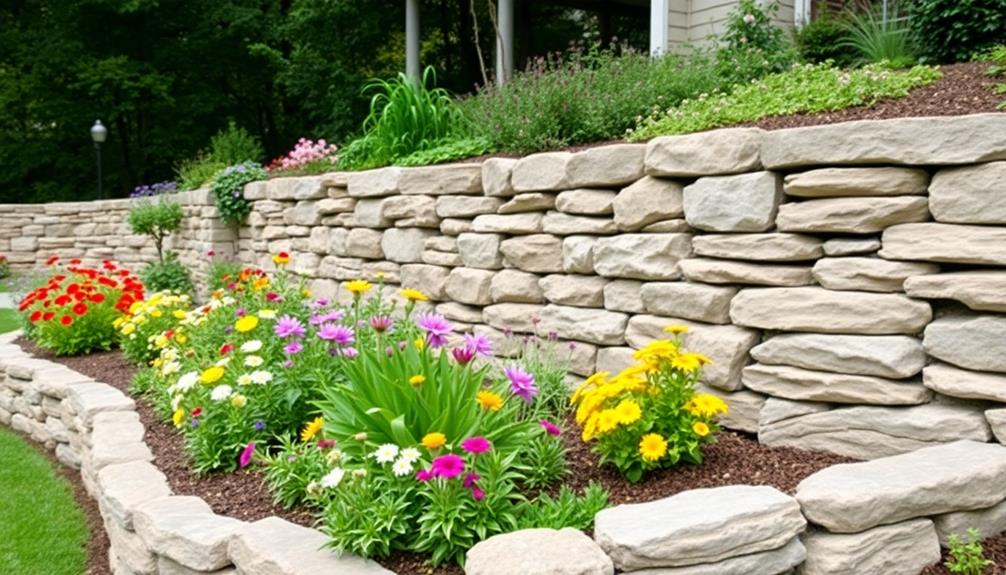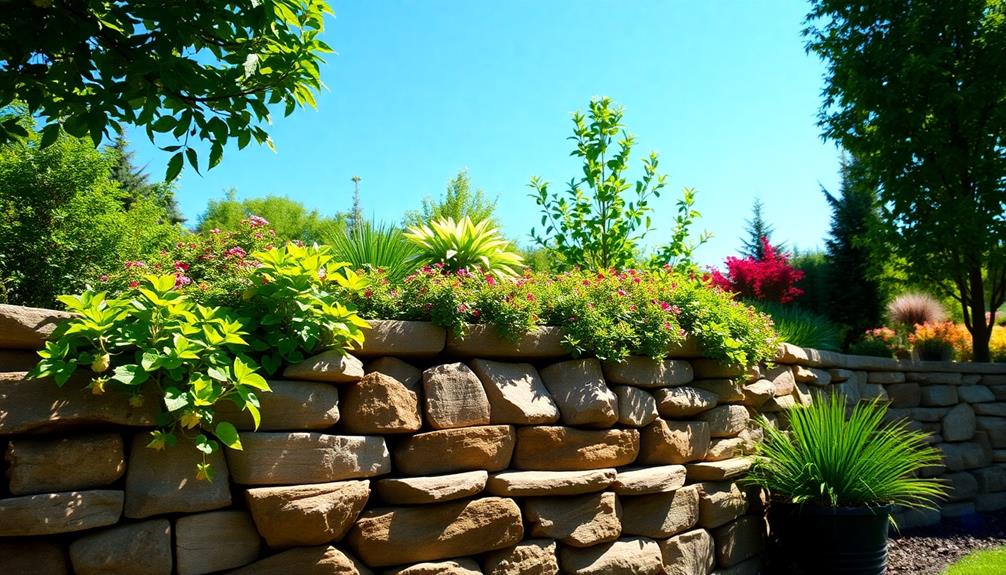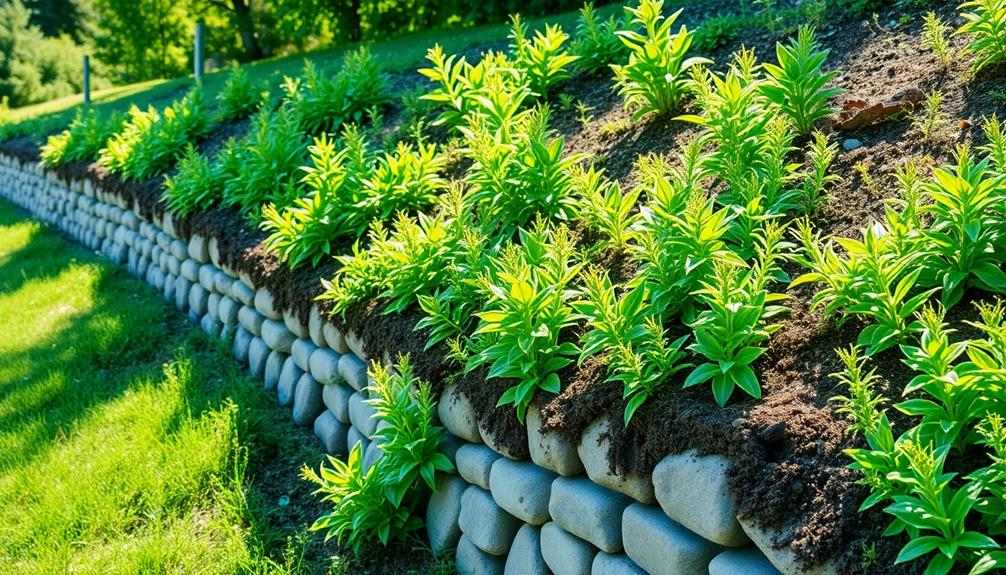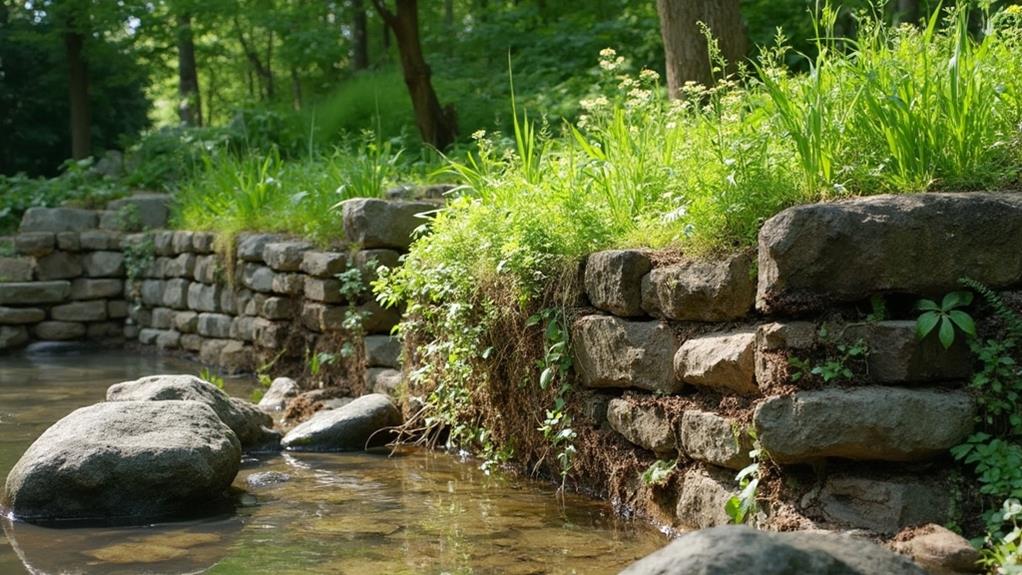Effective retaining wall maintenance involves a thorough approach to guarantee structural stability, functional efficiency, and alignment with aesthetic goals while considering environmental impacts. Start by inspecting the wall for cracks or shifting, verifying proper water drainage, and checking joint integrity. Preventative measures include clearing debris and vegetation, applying protective sealants, and promptly repairing minor damages. Material-specific considerations, such as monitoring concrete for spalling or timber for rot, are essential for longevity. It is vital to manage water runoff and employ native plants to blend the structure naturally with the landscape. By understanding these elements, further insights can be uncovered.
Table of Contents
ToggleWalls Contractor Highlights
- Inspect for cracks, shifting, and signs of structural instability.
- Ensure effective water drainage and control of erosion around the wall.
- Examine mortar, joints, and connections for integrity and wear.
- Monitor for vegetation growth that might damage the wall structure.
- Conduct regular cleaning and minor repairs to maintain functionality and aesthetics.
Purpose of Retaining Walls

Retaining walls serve a multifaceted purpose, primarily enhancing structural stability by providing critical support to vertical soil masses and preventing unintended soil movement. They play an essential role in erosion control by effectively managing water flow and minimizing soil displacement, thereby protecting landscapes from degradation.
Certain materials, such as boulder retaining walls, create a natural appearance and add to the durability and uniqueness of the wall, which complements various landscape styles. Additionally, retaining walls contribute to aesthetic landscape integration, blending functionality with visual appeal and complementing the overall design of outdoor spaces while supporting a sustainable environment.
Structural Stability Importance
Any individual involved in landscaping or construction likely understands the critical role of structural stability in retaining walls. These walls, essential to a myriad of projects, are not merely ornamental but serve as indispensable components in maintaining the longevity and safety of built environments.
The paramount function of retaining walls is to manage soil at two different levels on either side; hence, their structure must be unwavering. Stability guarantees the wall can withstand substantial lateral earth pressure, which is exaggerated by moisture and other environmental factors.
Structural stability is not just a design consideration but a reflection of meticulous planning and engineering insight. It encompasses the materials chosen, the engineering methods employed, and the eventual construction techniques deployed. A wall that embodies robust stability does more than just endure; it confidently supports the integrity of the surrounding landscape and infrastructure.
For communities seeking reassurance about their investment, ensuring a retaining wall is structurally stable is akin to laying a firm foundation, creating a collective sense of security and trust. Attention to this detail fosters a sense of belonging, as property owners and builders participate in a shared endeavor emphasizing not merely function but reliability and safety.
Erosion Control Role
Beyond structural stability, another indispensable function of retaining walls is their role in erosion control. Retaining walls are meticulously designed to hold back soil and manage the gravitational forces that contribute to erosion, preventing the displacement of earth and subsequent land degradation. In environments where rainfall is frequent or soil compositions are susceptible to erosion, a well-constructed retaining wall serves as a bulwark against nature's destabilizing forces, preserving the integrity of landscapes and preventing potential property damage.
The technical prowess of retaining walls in erosion management stems from their ability to direct water flow, minimizing surface runoff and facilitating proper drainage. This process is vital, as uncontrolled water movement can accelerate soil erosion and harm surrounding ecosystems. Retaining walls also provide a means to create level areas on sloped terrain, efficiently transforming previously unusable land into functional space while simultaneously tackling soil shifting challenges.
In a community where land preservation is a collective goal, recognizing the erosion control role of retaining walls fosters a sense of shared responsibility. Whether safeguarding a home, a public park, or agricultural terrain, these structures are indispensable in cultivating a balance between human and natural landscapes.
Aesthetic Landscape Integration
Aesthetic landscape integration is a fundamental aspect of retaining wall design, bringing both beauty and functionality to outdoor spaces. These structures ideally harmonize with their surroundings, enhancing the overall appeal of gardens, parks, and residential areas while also serving their primary purposes, such as soil retention and erosion control. When a retaining wall is artfully designed, it elevates the landscape, transforming functional necessities into stylish features. To achieve this integration, the selection of materials, texture, and color is paramount, as it enables that the wall complements existing natural elements and architectural designs.
Retaining walls can be tailored to meet the specific aesthetic desires of a community, creating a sense of belonging and cohesion. Utilizing materials like natural stone, interlocking concrete blocks, or timber provides varied options to fit diverse stylistic directions. In addition, the incorporation of plant life along the wall can soften the harsh lines of constructed elements, creating a seamless link between built and natural environments. Improper design or neglect in maintenance can disrupt this harmony; consequently, regular inspections and care are essential to preserve their visual appeal, ensuring these structures remain an integral and cherished part of the landscape.
Benefits

Retaining wall maintenance offers numerous advantages, including improved structural integrity that prevents soil erosion and potential wall failure. Proper maintenance can also guarantee that boulder retaining walls keep soil in place, helping to battle gravity effectively.
Additionally, it enhances aesthetic appeal by preserving the wall's original design and appearance, which contributes to the overall beauty and value of the surrounding landscape. By adhering to cost-effective maintenance practices, property owners can tremendously prolong the lifespan of their retaining walls, thereby optimizing their investment over time.
Improved Structural Integrity
One of the primary benefits of regular maintenance for retaining walls is the marked improvement in their structural integrity. Retaining walls, being bastions against erosion and soil displacement, require periodic attention to guarantee they continue to function ideally. Maintenance routines, which can include inspections for cracks, shifting, and water drainage efficacy, lead to early detection of potential issues that might compromise structural stability. By addressing these concerns promptly, the likelihood of significant damage is greatly reduced, thereby preserving the wall's durability and its role as a reliable safeguard.
Routine maintenance also involves reinforcing weak areas, which enhances the overall foundation of the wall. Such efforts prevent gradual wear and tear from escalating into serious damage that could threaten not only the wall's lifespan but also the safety of surrounding landscapes and infrastructures. For communities, these activities foster confidence in shared spaces, guaranteeing everyone enjoys environments that are thoughtfully cared for and structurally sound.
Thus, investing in regular retaining wall upkeep means that these crucial barriers are upheld in a condition that promises longevity and strength, bringing peace of mind to those who live, work, and thrive within their protective reach.
Enhanced Aesthetic Appeal
Regular maintenance of retaining walls not only guarantees structural stability but also considerably enhances their aesthetic appeal. With dedicated care, the visual integrity of these essential landscape elements is preserved, underscoring a sense of pride and belonging for property owners and communities.
Maintenance routines typically encompass cleaning techniques, ensuring that unsightly stains, dirt, and plant overgrowth do not mar the wall's appearance. This proactive approach allows the natural textures and colors of the materials to shine through, fostering a well-kept and inviting environment.
In addition to cleaning, ongoing inspections and repairs address minor surface defects before they evolve into significant eyesores. Small fissures or chipped surfaces, if promptly managed, maintain the wall's seamless appearance, upholding its design aesthetic. This meticulous attention to detail distinguishes a property, rendering it an asset not only in functional terms but as a visual landmark within the community.
Furthermore, periodic maintenance may involve enhancing the wall's appearance through modern design implementations or updates, such as strategic lighting or complementary landscaping. These enhancements serve to integrate the wall into its surroundings aesthetically, reflecting the collective aspirations of the community. This dedication to beauty and design aligns with a shared commitment to preserving an environment that residents are proud to call their own.
Prolonged Wall Lifespan
A well-maintained retaining wall offers the substantial benefit of a prolonged lifespan, minimizing the need for costly repairs or premature replacements. By investing in regular maintenance, property owners can guarantee that their retaining walls remain robust and resilient against environmental and structural stressors.
Essential maintenance activities such as inspecting for cracks, addressing drainage issues, and cleaning accumulated debris can dramatically extend the wall's functionality. These proactive measures not only enhance durability but position the wall as a steadfast structural component within the property's landscape.
Beyond the immediate structural advantages, maintaining the longevity of a retaining wall fosters a sense of stewardship and community pride. As well-cared-for structures stand the test of time, they contribute to the aesthetic continuity and structural integrity of shared landscapes. This continuity fosters a collective sense of belonging and responsibility among neighbors and community members, as enduring walls become part of the communal heritage.
Understanding the intricate interplay of maintenance and longevity for retaining walls empowers property owners and communities alike to steward these structures thoughtfully. This mindful stewardship guarantees that the retaining walls will continue to fulfill their crucial roles in landscape design and soil stabilization for years to come.
Cost-Effective Maintenance Practices
In addition to enhancing the longevity of retaining walls, adopting cost-effective maintenance practices provides meaningful financial benefits. Implementing strategic maintenance not only preserves the wall's structural integrity but also reduces the likelihood of costly repairs.
Regular inspections facilitate early detection of minor issues, such as small cracks or drainage problems, which can be addressed before they escalate into major structural failures. This proactive approach guarantees that the wall remains stable and functional, minimizing the need for substantial expenditures.
Preventive measures, like maintaining proper drainage systems, considerably reduce pressure on the wall, thereby prolonging its service life. Utilizing materials that are both durable and affordable for repairs or reinforcements further optimizes costs. Additionally, periodic reinforcement with appropriate materials can enhance the wall's ability to withstand environmental stresses, ensuring that maintenance remains both effective and economical.
Soil Erosion Control Tips

Maintaining the integrity of your retaining wall requires strategic measures to prevent soil erosion, which plays a pivotal role in ensuring structural stability. Effective drainage solutions are paramount, as they alleviate water pressure and prevent soil displacement, while vegetation and robust ground cover serve to anchor the soil, mitigating erosion through natural means. Regular wall inspections are equally indispensable, allowing for the early detection and resolution of potential issues before they escalate into significant problems.
| Tip | Benefit |
|---|---|
| Effective Drainage | Reduces water pressure and soil displacement |
| Vegetation and Ground Cover | Anchors soil naturally to prevent erosion |
| Regular Wall Inspections | Early detection of potential erosion issues |
Effective Drainage Solutions
Properly designed drainage is instrumental in guaranteeing the longevity and stability of retaining walls, preventing the detrimental effects of soil erosion. An ineffective drainage system can lead to water accumulation behind the wall, increasing hydrostatic pressure and potentially compromising the structural integrity. To mitigate such risks, strategic implementation of effective drainage features is critical.
Among these, the use of weep holes positioned at regular intervals provides a necessary outlet for water, reducing pressure buildup. Incorporating a drainage blanket, often composed of gravel or crushed rock placed behind the wall, serves as a secondary line of defense, enabling water to percolate efficiently. Coupling this with a perforated drainage pipe at the base ensures continuous water discharge. These pipes are often embedded within the gravel, directing water away from potential weak points.
Additionally, the integration of geosynthetics, such as geomembranes and geogrids, can reinforce the soil's stability and help manage water flow, consequently preserving the structural foundation of the wall.
Vegetation and Ground Cover
Supplementing effective drainage with appropriate vegetation and ground cover can dramatically enhance soil erosion control around retaining walls. When deciding on the best vegetative additions, consider indigenous plants adapted to the local climate and soil conditions. Native species typically have deep root systems that reinforce soil stability, minimizing the risk of erosion-induced wall failure. They also require less maintenance and water, fostering a sense of sustainability and responsibility within your landscape design.
Ground cover plants like creeping thyme or vinca minor can contribute substantially to erosion control. Their sprawling growth habit guarantees that bare soil is quickly covered, minimizing direct run-off impacts and reducing the erosion rate. For a natural, cohesive aesthetic, use a variety of shrubs and perennials that can coexist harmoniously, offering a multilayered defense against soil displacement.
The presence of mulch around these plants also serves to anchor the soil effectively by protecting it against heavy rain. It encourages water retention in the soil, supporting both the plants and the integrity of the retaining wall. By integrating strategic plantings with gravel or rock mulch, one can achieve both functional and visually appealing erosion control, nurturing a garden that is both robust and inviting.
Regular Wall Inspections
Regular inspections of retaining walls serve as a critical safeguard against potential hazards stemming from soil erosion. As members of a conscientious community, it is fundamental to recognize that retaining walls play an integral role in maintaining soil stability and landscape aesthetics.
By dedicating time to conduct thorough inspections, we collectively protect these structures against the multifaceted threats posed by natural forces. This responsibility includes diligently checking for cracks, bulges, or misalignments that may indicate underlying issues such as shifting soil or inadequate drainage.
Communities should ideally establish a routine inspection schedule, typically semi-annual, to guarantee early detection of vulnerabilities. During these evaluations, it is indispensable to pay close attention to the wall's foundation and surface integrity, as even minor fissures can evolve into significant structural challenges.
In addition, inspecting nearby drainage systems for blockages or leaks is imperative, as effective water management is pivotal in the battle against erosion.
Walls Contractor FAQ
How Often Should Retaining Walls Be Inspected for Maintenance?
Regular inspections of retaining walls are paramount for community safety, ideally conducted annually. Seasonal evaluations may be warranted depending on environmental conditions and wall material composition, ensuring collective security and structural integrity remain uncompromised for our shared spaces.
What Signs Indicate Structural Damage in Retaining Walls?
Structural damage in retaining walls is indicated by visible cracking, bulging, or leaning, water seepage, and misalignment of wall segments. Timely identification fosters community safety and preserves the shared spaces essential for our harmonious living environments.
Can Plant Growth Affect the Integrity of Retaining Walls?
Plant growth can compromise the structural integrity of retaining walls by exerting pressure on the wall and creating moisture retention, which can lead to deterioration. Incorporating vegetation responsibly fosters sustainable coexistence, ensuring community landscapes remain both safe and beautiful.
What Are Common Materials Used in Retaining Wall Constructions?
Common materials utilized in retaining wall construction include concrete blocks, poured concrete, treated lumber, natural stone, and brick. Selecting the appropriate material fosters durability and aesthetics, aligning with community standards and ensuring structural integrity within diverse environments.
Is Professional Inspection Required for Retaining Wall Maintenance?
Professional inspection of retaining walls is essential for early detection of structural issues, enhancing safety and longevity. Expert evaluations offer reassurance and foster a sense of community through informed maintenance, collectively safeguarding property investments and shared environments.







